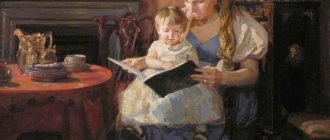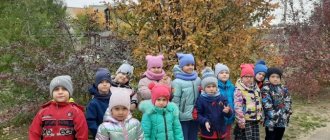Children's Journalism Project
Author:
Karabasheva Rushana Arkinovna,
teacher at MBDOU "Brusnichka"
Yamalo-Nenets Autonomous Okrug, Purovsky district, Purpe village
Relevance
The Federal State Educational Standard of Preschool Education defines as one of the target guidelines at the stage of completion of preschool education that “the child has a fairly good command of oral speech, can express his thoughts and feelings, can use speech to express his thoughts, feelings and desires, construct a speech statement in a communication situation.” For the successful speech development of preschoolers, it is necessary to create conditions in which they could talk about what interesting things happened in the group or at home, share their impressions, and express their opinions. Communication activities are closely interconnected with gaming activities. In the game, children communicate most freely, express their emotions, and reflect their knowledge of the surrounding reality, so we considered it possible to implement the game project “We are journalists.”
Project problem:
Analysis of the pedagogical process indicates that teachers experience serious difficulties in organizing work on the speech development of preschool children. Speech is the leading means of communication. However, it is used by the child as a means of communication in a situation that arises only when necessary and if there is a desire to enter into verbal interaction. The inability to organize constant meaningful verbal communication, taking into account the needs of the child, sometimes leads to underdevelopment of speech. The task of educators is to stimulate meaningful, productive communication between the child and adults and other children in various activities. Organizing situations that create the need for verbal interaction in play, during the learning process, is the professional responsibility of every kindergarten teacher. The theory and practice of preschool education have convincingly proven the need for specially organized activities for speech development, the formation of speech skills, and the mastery of coherent monologue speech.
Project goal: to promote the development of children's communication skills in play activities and children's social competence; direct children's interest from the process of playing to the process of obtaining results. Dialogue, creativity, knowledge, self-development are the fundamental components of the project.
Project objectives:
Educational: Improve monologue and dialogic forms of speech; develop the ability to conduct dialogue between adults and children; form correct sound pronunciation, structure phrases in dialogue, improve grammatical skills (declension of nouns, agreement of adjectives with nouns, use of verbs, participles, adverbs); teach children to construct independent statements, the ability to express their thoughts in detail, coherently, logically, with semantic completeness, grammatical design, and expressiveness; expand and activate your vocabulary.
Developmental: improve children’s ability to construct independent statements; — develop social and communication skills and effective interaction of children with each other, employees, parents and guests of the kindergarten, the ability to enter into dialogue; develop vital skills: cope with anxiety, consider your capabilities, make choices and decisions; to form in preschoolers an idea of the social role of adult labor and the importance of individual professions in the life of society; develop in children curiosity, observation, activity, and the ability to speak in public.
Educational: to cultivate a sense of belonging to a group and to consolidate positive emotions from a common, creative endeavor; cultivate a respectful attitude towards people of different professions and their work; Build independence and self-confidence in children.
Type of project: practice-oriented cognitive-game creative open Location of the project: MBDOU Project participants: children 6-7 years old, educators, parents.
Duration: long-term project
Methodical techniques
Modeling Explanation Conversation Questions Examination Didactic games Example of conducting an interview
Planned result : Mastery of coherent dialogic and monologue speech through studying the basics of the journalist profession. Development of communication skills and creative potential of each child as a subject of relationships with himself, successful interaction of children with each other, employees, parents and guests of the kindergarten. Creating in preschoolers a sense of belonging to a group, developing positive emotions from a common, creative activity. Cooperation with the family in the cognitive and social development of a preschooler and preparation for school
MAGAZINE Preschooler.RF
Children's journalism in kindergarten.Kopylova Tatyana Mikhailovna, MDOU “Kindergarten No. 126 in Borzya” , Borzya, Russia
In the context of the implementation of the Federal State Educational Standard for Preschool Education, a special place is occupied by developmental technologies aimed at the child - the main participant in the pedagogical process. Developmental technologies help preschoolers become successful, creative, and skillfully navigate various situations. One of these technologies is “children’s journalism,” which helps children receive information in a relaxed, playful way. Interesting stories, originality, active involvement of children, parents and social partners in educational activities - all this makes children's journalism popular and exciting. The use of children's journalism has advantages that can affect the quality and effectiveness of educational activities. Firstly, children gain new cognitive experience, and secondly, journalistic activity contributes to the development of curiosity, creativity, discipline, intellectual and social competence.
Based on this, we decided to organize a press conference in the kindergarten. A long-term project on this topic was developed and implemented. The press center has a journalism corner, it has its own logo, badges, a laptop for work, a camera, a video camera, and microphones. The press center stand contains various information about events in the life of the kindergarten. The work of the press center is organized with the help of teachers, children and parents. The editor-in-chief of the press center is a senior educator, proofreaders and photojournalists are educators and parents, but journalists, announcers, and correspondents are children. Everyone takes their role not only responsibly and seriously, but also receives pleasure, admiration and a sense of pride.
Journalistic activity has become an integral part of the pedagogical process. It not only improves the professional level of teachers, but also reveals the creative potential of preschoolers. And most importantly, children really enjoy doing this interesting activity.
By playing at being journalists, preschoolers learn a lot, because children's journalism provides enormous opportunities for cognitive activity, emancipation, and contributes to raising a successful, inquisitive child. While playing, children share stories about the life of the kindergarten, about people, events and holidays. In a word, young journalists are interested in everything!
During the implementation of the project, children learn to recognize and distinguish between types and genres of journalism, build their communication, focusing on the unique “child-adult” , which involves communication on equal terms. Preschoolers get acquainted with the professions of a journalist, sound engineer, commentator, correspondent, and announcer. Children learn to conduct interviews purposefully and answer questions competently.
In organizing journalistic activities, modern interactive methods are used: interviewing, cluster, immersion , syncwine, “Brownian motion” . These methods help children master the means of communication and enrich their vocabulary.
During the project activities, parent-child relationships also develop. “In the Lens” was created . The mini-museum contains magazines, newspapers published many years ago, there are old cameras, video cameras, and a typewriter.
Work has also been organized with social partners - with the editorial office of the newspaper “Daurskaya Nov” , a school and a children's library. The young journalists visited the editorial office, where they saw firsthand the work of correspondents, newspaper collectors, and the editor-in-chief. In the kindergarten, a meeting was held in the format of a press center with school journalists, where preschoolers interviewed their older friends from school. And they, in turn, demonstrated their creative abilities: they sang, played musical instruments, talked about themselves, and visited the mini-museum “In the Lens” .
Young journalists are the main participants in the publication of the “living newspaper” “News from Skazka” , in the production of the newspaper “Visiting Skazka” , which creates the conditions for their first experience in journalism. The news covers all the interesting and significant events taking place in the kindergarten. The guys choose the topics for reporting themselves. This could be news from groups where correspondents talk about life and events in kindergarten groups. These are stories about holidays and kindergarten competitions, about everyday life, about interesting people and events. In the process of work, preschoolers acquire communication skills with people of different ages, the ability to present themselves, and correctly formulate their thoughts. While working on the program “News from a Fairy Tale,” children learn to conduct a dialogue, highlight semantic links in the dialogue, and conduct interviews. They develop the ability to obtain information from various sources, ask and answer questions, reasoning and expressing their own point of view. When viewing the footage, the guys notice and discuss mistakes in their own speech, look at themselves from the outside.
Organizing joint activities between adults and children, based on the “children’s journalism” , is a promising direction in children’s activities, which allows the child to feel like a free individual, gives the opportunity to freely communicate with adults and peers, and express their views.
Bibliography:
- Makarov A.V. Fun journalism for children and adults. Online book 2021.
- Tolstova, N.P. Children's television: resources for speech correction of preschoolers /N. P. Tolstova // Speech therapist. 2013. No. 6.
- Rogunova O. A., Yarovaya T. A. Children's television as an innovative form of work with parents // Innovative pedagogical technologies: materials Kazan: Buk, 2021. 132 p.
| Next > |
Article on the topic: “History of children's journalism”
History and specifics of children's journalism
"World history with great memories
decorates the world for the mind, and the Russian decorates
The Fatherland where we live and feel.”
N.M. Karamzin
The tasks and functions of children's journalism predetermined its close interaction with various social institutions - education, science, culture, religion.
The purpose of this article is to address the history of the development of children's journalism. The Russian press for young readers, as opposed to “adult” ones, began with a magazine. Children's journalism in our country has a rich history; in my article I will try to trace the history of the development of children's journalism from its inception and highlight trends in its influence on the development of a child, depending on the era, political system, and worldview of society.
Children's journalism is a unique part of media culture. On the one hand, these are full-fledged publications, programs selected taking into account the age of the audience, its psychology, which are part of the media. On the other hand, this is a phenomenon of pedagogy that carries educational and educational components.
Journalism for children in Russia originates from the magazine of the educator Nikolai Ivanovich Novikov, “Children's Reading for the Heart and Mind.” This magazine was published weekly as a supplement to the Moscow Gazette in 1785-1789. After its closure in 1789, “Children's Reading” was repeatedly republished in collections.
The nineteenth century is the time when the so-called “culture of childhood” appeared. If previously a child was understood as a “little adult,” then from now on Europeans recognize childhood as a special state and children as a distinctive subculture; many literary, musical, and theatrical works are created specifically for young art fans. Russia is also joining the flow of European “culture of childhood.” At first, Russian children's magazines were literary and artistic publications, the age range of which was quite wide (from 4 to 18 years), and there was no distinction between magazines for girls and boys. The materials in them were often not distinguished by the simplicity of the language, the pages were poor in illustrations, and the didactic tone of the narrative could not interest the child.
Among children's journalism, there have been debates about what publications for the younger generation should be like. Some (S.N. Glinka) believed that children’s literature and children’s journalism should be considered an original and full-fledged phenomenon, similar to “adult” works and publications. They advocated for simplification of the language of materials, the presence of illustrations, and a special genre structure.
Others (D.A. Valuev), on the contrary, sought to ensure that the children's press was more like magazines and newspapers for older generations. His “Library for Education” lacked an entertainment section and illustrative materials; most of the articles were devoted to the history of Russia, biographies of prominent figures in Russian science, culture, and government activities.
At this time, two opposing trends can be seen in children's periodicals:
- the desire of some magazines (“Soulful Word”) to protect children from the cruelty and injustice of the adult world (“rose childhood”);
- attempts by other magazines (Children's Holidays) to prepare children for their future adult life, to instill in them the desire from a young age to be aware of what is happening in the world, incl. and in politics.
The February and October revolutions gave rise to changes in all spheres of public life. The communists saw children's journalism and children's literature as a powerful propaganda tool and sought to take the child's upbringing under social and ideological control from a very young age.
Soviet children's periodicals produced the best examples of magazines: “Funny Pictures”, “Murzilka”, “Pioneer”, “Koster”, “Chizh” and “Hedgehog”. Despite the colossal ideological content of the publications, their quality, level of publications, and illustrations were very high. “To teach while entertaining” was chosen by many writers of that time as their motto. The emphasis in the publications was on the denial of individuality, collective education, and the good goals of the domestic and foreign policy of the Soviet state were explained to children.
With the dissolution of the Soviet Union, a powerful flow of Western periodicals poured into the Russian market. The state lost its monopoly on the media. All the processes that occurred with the formation of the new Russia also affected children's magazines. The circulation of the largest Soviet publications fell: “Murzilka”, “Pioneer”, etc. And at the same time, new magazines appeared that immediately demonstrated global standards: the Russian “Prostokvashino” and the translated “Ninja Turtles”.
It can be noted that since the beginning of the 90s, children's print media have divided into three streams: magazines whose history dates back to the USSR ("Veselye Kartinki", "Murzilka"), Russian magazines that appeared after the collapse of the Union ("Funny Pictures", "Murzilka"). Prostokvashino”, “Toshka and”) translated editions (“Mickey Mouse”, “The Little Mermaid”). The children's press has actually become an analogue of the adult press. In addition to popular science, literary, artistic and general magazines, publications of exclusively entertainment nature, presses separately for boys and girls, also appeared. (“Playing with Barbie”, “Winnie the Pooh”)
Entertainment journalism (both domestic and translated) has lost any national content. Here, it is necessary to note the tendency that materials of a patriotic, educational, and local history nature remained on the pages of either special publications or regional universal ones. The process of globalization is also manifested in changes in values that existed in Soviet times. Magazines strive to instill pan-European standards of morality and etiquette, and promote the Western way of life.
In the modern Russian children's press it is difficult to find a high-quality literary component, which has always been given much attention in domestic children's magazines and newspapers. N.M. Karamzin, A.P. Chekhov, D.N. Mamin-Sibiryak, A.L. Barto, S.Ya. Marshak collaborated with magazines for children.
Outstanding writers, publicists, artists, scientists and poets took part in the publication of the leading children's magazines of the era of development of children's periodicals we are considering. They left a rich heritage that has not yet been fully studied; they were the first to solve problems such as the connection between the press and literature, pedagogy, appeal to scientific and educational material, and the peculiarities of a child’s perception of text.
On the pages of periodicals for children, genres of Russian literature were formed, various creative techniques were used, and the connection with the traditions of folk literature - with folklore - was strengthened. Magazines taught children to resist evil, practicality, and cultivated love.
Currently, there is a revival of children's journalism in the best Russian traditions. Publishers of new magazines have an excellent example to follow in the form of a huge array of Russian publications from the late eighteenth to early twentieth centuries.
The specifics of children's journalism at all times have been determined by a clearly expressed age-specific focus on the audience. In this regard, it uses special, specific techniques for displaying reality, its own means of expression, forms, and methods of contact with the audience.
Literature
1. Gaimanova E.V. Magazines for children and youth in the context of domestic artistic culture of the first quarter of the 19th century. / Yaroslavl Pedagogical Bulletin. Humanitarian sciences. 2011. No. 1. P. 269 – 272.
2. Grabelnikov A.A., Russian journalism at the turn of the millennium. Results and prospects. – M.: RIP-Holding, 2001. – 236 p.
3. Esin B.I. History of Russian journalism (1703 - 1917). – M.: Flinta: Nauka, 2006. – 464 p.
4.Kuznetsov, I.V. History of domestic journalism / I.V. Kuznetsov. – M.: Flinta, 2006. – 410 p.
5. Hovsepyan, R.P. History of modern domestic journalism / R.P. Hovsepyan. – M.: Journalism, 1999. – P.229-232.
Specialist in CR of ORC "Rodnik" A.V. Mishagina






